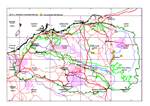Click on images
to enlarge



Photographer: B.R. Maslin

Photographer: B.R. Maslin

Plant in cultivation (Karratha Primary School). Photographer: B.R. Maslin

Photographer: B.R. Maslin

Photographer: B.R. Maslin

Photographer: B.R. Maslin

Photographer: M.W. McDonald

Photographer: M.W. McDonald

Photographer: B.R. Maslin

Photographer: B.R. Maslin
Botanical name
Acacia trachycarpa x tumida var. pilbarensis
Description
Rounded or obconic, shapely shrubs or small trees 2-5 tall (to 6 m in cultivation), either dense and bushy (especially in cultivation) or spreading with an untidy aspect, single-stemmed or sparingly branched at or near ground level. Bark grey, normally pseudo 'Minni Ritchi' towards base of main stems (i.e. grey and exfoliating in ±oblong, short strips which are mostly very slightly recurved at the ends) but occasionally longitudinally fissured, underlying new bark reddish-brown, smooth and light grey on upper branches. Branchlets normally glabrous, rarely sparsely appressed -hairy towards apices. Stipules persistent, minute (0.5-1 mm long), triangular, dark brown. Phyllodes broad-linear to very narrow elliptic, 6-13 (-15) cm long, 4-7 (-10) mm wide, not rigid, often wide-spreading, normally slightly recurved, sometimes straight, slightly shiny (at least when young) or dull, normally glabrous, rarely sparsely appressed -hairy, dark- to mid-green; parallel longitudinal nerves numerous, fine (but slightly raised when dry), close together but not touching (0.2-0.3 mm apart), sometimes sparingly anastomosing, the central nerve more pronounced than the rest; upper margin flat and widened (0.3-0.6 wide), about twice width of lower margin; apex acute to obtuse-mucronate, innocuous. Gland not prominent, situated on upper margin of phyllode 0-3 mm above pulvinus. Inflorescences a mixture of simple axillary spikes and short racemes (both types normally found on the one plant), racemes 1-20 (-35) mm long and commonly growing out at apex into a new shoot, simple (i.e. not racemose) inflorescences in axil of phyllodes; peduncles (2-) 6-12 (-14) mm long, glabrous or rarely sparsely appressed -hairy; spikes prolific and showy, golden, 15-25 mm long, the flowers ±densely arranged. Flowers 5-merous; calyx dissected for about ½-¾ its length, short-villous. Pods (few seen, mostly immature), flat, ±narrowly oblong but shallowly to deeply constricted between the seeds, 2-10 cm long, 9-11 mm wide, thinly coriaceous, straight to strongly curved, reticulately nerved, glabrous, pale brown, lightly pruinose. Seeds (few seen) longitudinal in pods, obloid-ellipsoid, 7 mm long, 4 mm wide, very dark brown, smooth and glossy except bordering the areole where it is dull to sub- shiny and verriculose (i.e. pimpled); funicle flat and gradually expanded into a once-folded, dull yellow (when dry) and shiny (i.e. waxy texture) aril.
Characteristic features
Shrubs or small trees with grey bark shedding in a pseudo Minni Ritchi fashion at extreme base of main trunks. Stipules persistent, triangular, small (0.5-1 mm long), dark brown. Phyllodes mostly 6-13 cm long and 4-7 mm wide, finely multi-nerved, upper margin flat and about twice the width of the lower margin. Spikes prolific, peduncles mostly 6-12 mm long. Pods broad (9-11 mm) and flat, constricted between seeds, sub-straight to strongly curved, pale brown, reticulately nerved, glabrous. Seeds with a narrow band of rough (pimpled) tissue bordering the pleurogram; funicle and aril waxy textured.
Distribution and ecology
Confined to the Pilbara of northwest Western Australia where it is scattered and relatively infrequent in the northern half of the region, north of the Fortescue River. It grows mostly in (often stony) sand along watercourses.
Flowering and fruiting period
Flowers from May to June or July. It appears as though little fruit is produced by this hybrid; one pod containing a single mature seed has been collected in late October.
Affinities
The putative hybrid status of this entity has been determined from field observations and from critical examination of herbarium material. Acacia trachycarpa x tumida var. pilbarensis can be recognized in the field by its pseudo Minni Ritchi bark which is grey in colour and exfoliates in short, narrow, ±oblong strips which are mostly very slightly recurved at the ends (in A. trachycarpa the bark is burgundy to red-brown and the strips are strongly recurved at the ends, thus producing a typical Minni Ritchi bark; the bark of var. pilbarensis is not Minni Ritchi). Although the phyllodes are somewhat variable in size and curvature, they are broader than those of A. trachycarpa and often narrower than A. tumida var. pilbarensis (and unlike that variety the upper margin is clearly wider than the lower margin, a character that is best observed by viewing the phyllodes side-on). Also, the inflorescences are intermediate between the two putative parents with a preponderance of simple, axillary spikes (as in A. trachycarpa) intermingled with some short racemes ( var. pilbarensis has racemose inflorescences but the racemes are commonly longer than those found in the putative hybrid). Some specimens of this putative hybrid resemble A. eriopoda x tumida var. pilbarensis which occurs in the vicinity of Nullagine (see that entity for differences). Plants referable to the taxon described here as A. trachycarpa x tumida var. pilbarensis were erroneously referred to A. ancistrocarpa x trachycarpa by Maslin (1983).
Notes
Acacia trachycarpa x tumida var. pilbarensis has occasionally been used for amenity planting (in Karratha and Dampier) where it develops a handsome, bushy growth form and reaches 6 m in height. It has prolific showy spikes and the bark is interesting.
Conservation status
There is insufficient information at present concerning this entity to justify including it on the Department of Environment and Conservation's Declared Rare and Priority Flora List.
References
Maslin, B.R. (1983). Studies in the genus Acacia (Leguminosae: Mimosoideae) - 14. New taxa from north-west Western Australia. Nuytsia 4(3): 383-410.
